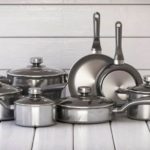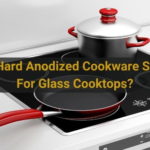Can you use Hard Anodized Cookware on Induction Cooktop?

Hard Anodized is basically aluminum that has been treated with an electro-chemical process. This makes the surface of the aluminum harder, nonreactive, and more durable. It has been said that it is nearly as hard as stainless steel but lighter in weight.
But the question is Can you use Hard Anodized Cookware on Induction Cooktop? In short, the short answer is most of the time No. As we already mentioned that hard anodized cookware is made from aluminum, which is not magnetic and therefore not compatible with induction cooktops.
However, some companies make hard anodized cookware with a magnetic stainless steel base. These products are compatible with both induction and traditional cooktops.
If you want to buy Hard Anodized Cookware that is compatible with induction, then check Circulon Symmetry 11-Piece Hard Anodized Cookware Set.
However, when searching for hard anodized cookware that is compatible with induction, make sure it’s base is made from stainless steel and check the product description before making your purchase.
What is hard anodized cookware and what are the benefits of using it over other materials?
Now that we’ve answered the question, “Is hard anodized cookware compatible with induction cooktops?”, let’s take a look at how it’s made and what benefits it offers.
Hard anodized cookware is made by submerging aluminum in an acid bath. This process causes a layer of aluminum oxide to form on the surface of the metal. The thickness of this layer can be controlled, which means that the cookware can be made to be very durable.
The aluminum oxide layer also makes the cookware nonstick, which is a major benefit for many cooks. Nonstick cookware is easier to clean and can prevent food from sticking to the surface and burning.
Some of the benefits of using this type of cookware
One of the main benefits of using hard anodized cookware is that it is highly durable.
In fact, the surface of hard anodized cookware is harder than regular anodized cookware and is less likely to scratch or chip. Additionally, hard anodized cookware is less likely to warp over time.
Another benefit of hard anodized cookware is that it is oven-safe up to 400 degrees Fahrenheit. This means that you can use it to cook your food in the oven without having to transfer it to a different dish.
Hard anodized cookware is nonstick, which makes it easier to cook with and clean. When food doesn’t stick to the surface of the cookware, it’s less likely to burn and make a mess.
Finally, hard anodized cookware is PFOA-free. This means that it doesn’t contain any harmful chemicals that can be released into your food.
How does induction cooking work and why is it becoming a more popular choice?
To understand why hard anodized cookware is not always induction compatible, you first need to understand how induction cooktop works.
The induction cooktop uses a magnetic field to generate heat. This means that the cooktop itself doesn’t get hot. Instead, the heat is generated by the cookware that is placed on the cooktop.
When a pan that is made of ferrous metal, such as stainless steel or cast iron, is placed on the cooktop, the magnetic field will cause currents of electricity to flow through the metal. This, in turn, will create heat that will cook your food.
Since aluminum is not a ferrous metal, it does not create a reaction with the magnetic field and is not compatible with induction cooking.
As we told you, some companies produce hard anodized cookware that is induction compatible. This cookware is made with a special alloy that allows it to create a reaction with the magnetic field.
So, if you are looking for hard anodized cookware that is induction compatible, be sure to check the label to make sure that it is made with the correct alloy.
Why induction cooking is becoming more popular?
Here are a number of reasons:
Induction cooking is faster
The first and most obvious reason induction cooking is becoming more popular is that it is faster than traditional cooking methods. With induction cooking, you can have a pot of water boiling in a matter of minutes.
More energy efficient than the traditional one
Induction cooking is also more energy efficient than traditional cooking methods. With induction cooking, the heat is generated directly in the pan, so there is no heat lost to the surrounding area. This makes induction cooking more efficient than gas or electric cooking, which can lose up to 30% of its heat to the surrounding area.
More precise than traditional cooking methods
Induction cooking is also more precise than traditional cooking methods. With induction cooking, you can control the heat with greater accuracy, which results in more consistent cooking.
Induction cooking is safer
Induction cooking is also safer than traditional cooking methods. With induction cooking, the heat is generated directly in the pan, so there is no risk of fire. Induction cooktops also have safety features that automatically turn off the cooktop if there is no pan on the burner or if the pan is removed from the cooktop.
Easy to clean
Induction cooking is also easier to clean than traditional cooking methods. With induction cooking, there is no risk of food sticking to the cooktop. And because there is no heat lost to the surrounding area, the cooktop stays cool to the touch, making it safer and easier to clean.
It is more consistent than traditional cooking methods
Induction cooking is also more consistent than conventional cooking methods. With induction cooking, the heat is generated directly in the pan, so there are no hot spots. This results in more consistent cooking.
How do you care for your hard anodized cookware so that it lasts longer and performs better?
Here are a few tips on how to care for your hard anodized cookware:
- Do not use metal utensils, as they can scratch the surface of the cookware.
- Avoid using abrasive cleaners or scrubbers.
- Do not put the cookware in the dishwasher.
- Dry the cookware thoroughly after washing.
- Do not store the cookware in a damp place.
By following these tips, you can extend the life of your hard anodized cookware and keep it performing at its best.
Conclusion
If you are looking for an alternative to nonstick cookware, hard anodized cookware is a great option. It is durable, heats evenly, and is easy to clean.
Hard anodized cookware is made of aluminum and has a hard, non-stick surface. It is also durable and can withstand high temperatures, making it a good choice for those who do a lot of cooking.
However, hard anodized cookware is not always induction compatible. So, make sure to check the compatibility to make sure it will work with your stovetop.
FAQs
What kind of cookware is best for induction cooktop?
The best cookware for induction cooktops is made of a magnetic-based material such as cast iron or stainless steel. Induction cooktops use a magnetic field to create heat, so cookware with a magnetic base will heat up the quickest and more evenly. Aluminum or copper cookware is not ideal as they are not magnetic-based and will not heat up as quickly or evenly.
How do I know if my cookware is induction compatible?
If your cookware has a metal base that is magnetic, it is likely induction compatible. If the base is made of glass or ceramic, it is not induction compatible. To test if your cookware is induction compatible, try sticking a refrigerator magnet to the bottom of the pan OR place a magnet on the side of the pan and see if it sticks.
Can I use my regular oven pans on an induction cooktop?
No, you cannot use regular oven pans on an induction cooktop. The induction cooktop uses a magnetic field to create heat, so only cookware with a magnetic base will work. Glass and plastic cookware is not compatible with induction cooktops.
What is the difference between an induction cooktop and a regular cooktop?
An induction cooktop uses a magnetic field to create heat, while a regular cooktop uses radiant heat. Induction cooktops are more energy efficient than regular cooktops as they heat up food quicker and more evenly.
They are also safer as they do not produce heat from the bottom of the pan, so there is less risk of burns. Induction cooktops are more expensive than regular cooktops, but they are becoming more popular in recent years.
What are the pros and cons of induction cooking?
The pros of induction cooking are that it is more energy efficient than other cooking methods, it heats up food quickly and evenly, and it is safer than other cooking methods. The cons of induction cooking are that it is more expensive than other cooking methods, it is not as common as other cooking methods, and it requires special cookware.
Related Posts:




